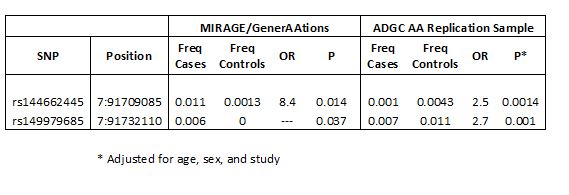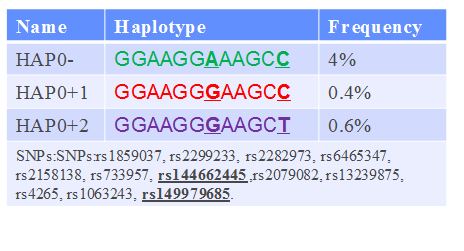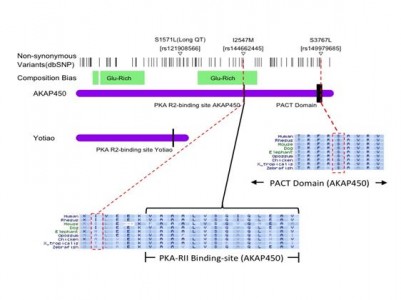Alzheimer Disease in African Americans
Our research team has focused on the genetic basis of AD in African Americans (AAs) for nearly 20 years. African Americans are about twice as likely as non-Hispanic Caucasians to have AD and show a different pattern of association with known AD genes. The AD risk associated with APOE ε4 heterozygosity is inconsistent in AAs compared to Caucasians. We have published extensively on genetic and environmental determinants of AD in two large samples of AAs including more than 500 AD cases and 500 cognitively normal elders.1-3 Our genome wide association studies (GWAS) performed in our AA cohorts and more recently in a much larger sample of AAs assembled by the Alzheimer Disease Genetics Consortium (ADGC) have confirmed association with some, but not all, of the known AD loci in Caucasians.4,5 In particular, the ABCA7 gene has a greater impact on AD risk in AAs compared to Caucasians. We also identified stretches of homozygosity across the genome that are associated with AD in AAs.6 In another study using a GWAS approach we identified several novel loci associated with a brain MRI measure of atrophy of the hippocampus, the portion of the brain affected earliest and most severely by AD. Each of the findings was supported by evidence in both Caucasians and AAs, however the most str ongly associated variants differed among the ethnic groups.7
To identify potentially functional AD genetic variants in AAs, we sequenced and analyzed the exomes of 7 AA AD cases from the MIRAGE Study.8 The 88,867 identified single nucleotide variants (SNVs) were filtered based on novelty, sequencing quality, predicted functionality, gene-network analysis findings, and previous association with AD. The 63 top-ranked SNVs were genotyped in 435 AA cases and 422 AA controls from the MIRAGE and GenerAAtions Studies. Among the 44 successfully genotyed SNPs, nominally significant association was observed with two rare missense mutations in AKAP9 which are < 1% frequent in AAs and have not been observed in Caucasians.
We replicated these associations in a much larger sample of AA AD cases and controls from the ADGC, and demonstrated that these mutations usually co-occur on the same infrequent (5%) haplotype and substantially increase risk of AD. Bioinformatic analysis indicates that one of the AKAP9 mutations (rs149979685) is likely damaging and located 5 amino acids away from the type II regulatory subunit of PKA binding site of the long AKAP9 isoform (dubbed AKAP450). The other mutation (rs144662445) is in the domain which anchors the long isoforms of AKAP9 to the centrosome. AKAPs bind or tether protein kinase A (PKA) and other signaling molecules to relevant target. The normal functions of AKAP9 are not well understood, however, disruption of the binding of PKA and AKAP9 at nerve terminals in the hippocampus has been shown to interfere with cellular mechanisms associated with spatial memory. AKAP450 has functional similarity with tau protein. This study indicates a potential new mechanism for AD and demonstrates that WES and follow-up association studies in an enlarged AA sample can lead to discovery of RVs that influence AD risk.
Currently, we are resequencing more than 100 AD candidate genes in 1,000 African American AD cases and controls to identify rare variants that cause AD in this population. We are also conducting experiments using cell lines from study subjects with identified AD risk alleles to determine the impact of these mutations on AD-related proteins including amyloid-beta and tau.
- Green RC, Cupples LA, Go RCPG, Benke KS, Edeki T, Griffith PA, Williams M, Hipps Y, Graff-Radford N, Bachman D, Farrer LA, for the MIRAGE Study Group. Risk of dementia among white and African American relatives of patients with Alzheimer’s disease. JAMA 2002; 287:329-336. PMID: 11790212 http://jama.jamanetwork.com/article.aspx?articleid=194571
- Graff-Radford N, Green RC, Go RCPG, Hutton ML, Edeki T, Bachman D, Adamson JL, Griffith P, Willis FB, Williams M, Hipps Y, Haines JL, Cupples LA, Farrer LA. Association between APOE genotype and Alzheimer disease in African Americans. Arch Neurol 2002; 59:594-600. PMID: 11939894 http://archneur.jamanetwork.com/article.aspx?articleid=781778
- Bachman DL, Green RC, Benke KS, Cupples LA, Farrer LA, for the MIRAGE Study Group. Comparison of Alzheimer’s disease risk factors in white and African-American families: the MIRAGE Study. Neurology 2003; 60:1372-1374. PMID: 12707449 http://www.ncbi.nlm.nih.gov/pubmed/12707449
- Logue MW, Schu M, Vardarajan BN, Buros J, Green RC, Go R, Griffith P, Akomolafe A, Obisesan TO, Shatz R, Borenstein A, Cupples LA, Lunetta KL, Fallin MD, Baldwin CT, Farrer LA, for the MIRAGE Study Group. Genetic variants at multiple loci influence Alzheimer disease risk in African Americans. Arch Neurol 2011; 68:1569-1579. PMID: 22159054 http://archneur.jamanetwork.com/article.aspx?articleid=1108047
- Reitz C, Rajbhandary R, Naj AC, Jun G, Vardarajan BN, … 29 co-authors…, Farrer LA, Pericak-Vance MA, Schellenberg GD, Mayeux. Variants in the ATP-binding cassette transporter, ABCA7, and the apolipoprotein E ε4 allele substantially and equally influence risk of late-onset Alzheimer’s disease in African Americans. JAMA 2013; 309:1483-1492. PMID: 23571587 http://jama.jamanetwork.com/article.aspx?articleid=1677372
- Ghani M, Reitz C, Cheng R, Vardarajan BN, Jun G, …36 co-authors…, Farrer LA, Pericak-Vance MA, Lee JH, Schellenberg GD, St George-Hyslop P, Mayeux RM, Rogaeva E, Alzheimer Disease Genetics Consortium. Association of long runs of homozygosity with Alzheimer’s disease among African Americans. JAMA Neurology 2015. In press. PMID: 26366463 http://archneur.jamanetwork.com/onlineFirst.aspx
- Melville S, Buros J, Parrado A, Vardarajan B, Shen L, Risacher SL, Alzheimer Disease Neuroimaging Initiative, Kim S, Jun G, DeCarli C, Lunetta KL, Baldwin CT, Saykin AJ, Farrer LA. Genome-wide association study of Alzheimer-related brain MRI traits. Ann Neurol 2012; 72:65-75. PMID: 22745009. http://onlinelibrary.wiley.com/doi/10.1002/ana.23644/pdf.
- Logue MW, Schu M, Vardarajan BN, Farrell J, Bennett , Buxbaum JD, Byrd GS, Ertekin-Taner N, Evans D, Foroud T, Goate A, Graff-Radford NR, Kamboh I, Kukull WA, Manly JJ, Alzheimer Disease Genetics Consortium, Haines JL, Mayeux R, Pericak-Vance MA, Schellenberg GD, Lunetta KL, Bald win CT, Fallin MD, Farrer LA. Two rare AKAP9 missense variants are associated with Alzheimer disease in African Americans. Alzheimers Dement 2014; 10:609-618. PMID: 25172201 http://www.sciencedirect.com/science/article/pii/S155252601402490X#


